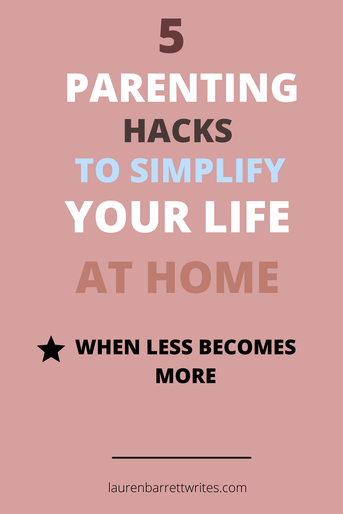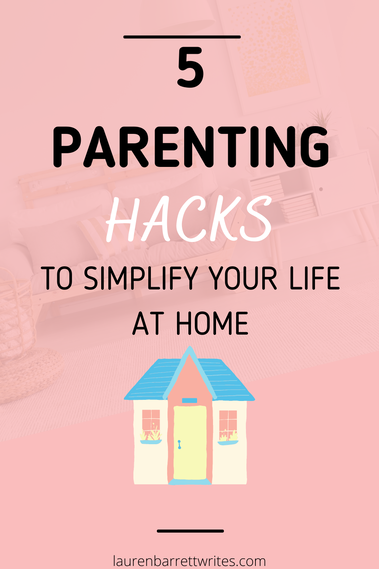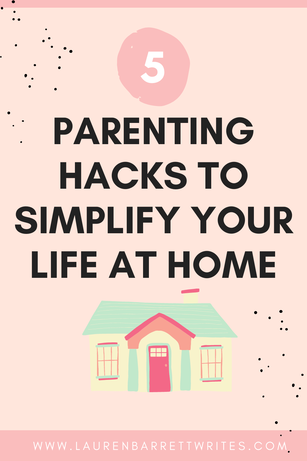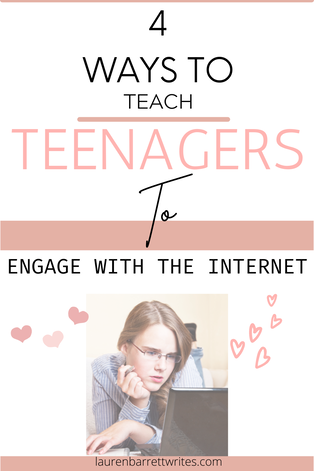|
Introduction
Less is more has been my mantra in parenting lately. There has long been the narrative that moms have to be tired, burnt out, and stressed, running around like a chicken with its head cut off (do people still use this idiom?). TV shows often depict a mom as being forgetful, clumsy, disoriented, and disheveled. While motherhood is certainly hard, and there are days where we are surviving instead of thriving, the overall theme of motherhood doesn’t have to be this way. Once we start to shift our mindset to less is more, we will start to see parenting to be more enjoyable. In today’s blog, I have 5 parenting hacks to simplify your life at home. Lauren Barrett Writes is a participant in the Amazon Services LLC Associates Program, an affiliate advertising program. As an Amazon Associate, I earn from qualifying purchases. Read more about these links in my disclosure policy. Table of Contents
Less is More: 5 Parenting Hacks to Simplify Your Life at Home
#1. Less Toys More toys in our child’s life doesn’t mean that they will be occupied and entertained more. In fact, it’s the classic proven example of when we are given too many options, we choose nothing or take no risks to try something new. The same is true with kids. The more toys they have to pick from, the more distracted they are and the less likely to use their imagination. While on the other hand, less toys means MORE chances to develop creativity, participate in MORE focused play, and encourage gratitude. What can you do if you have too many toys? 1. Do a toy rotation: Instead of keeping all of your kid’s toys out where he can access them, do a toy rotation where you gather toys to put in different bins. Every week or so, put one bin or collection of toys out while the other bins are hidden away. This is a win-win for you and your child.
2. Do a donation. You have my permission to get rid of some of those toys that are loud, require too many battery changes, and seemingly won’t shut off. Every 6 months or so, chuck those toys that are annoying or that your kids have outgrown or don’t use. If you wish to involve your kids, this is a great time to teach them about gratitude, sharing, waste, and excess. 3. Ask for gifts besides toys. Kids get a lot of toys for birthdays and holidays. Instead of having your kids get toys each time, ask for different kinds of gifts from loved ones and friends.
Having fewer toys in your home, means more meaningful play, conversations, and engagement with your kids.
#2. Less Commitments
Susie from Busy Toddler says it well. Being unbusy is a big deal to her. While she takes it to the extreme and doesn’t have her kids in any activities, it’s time you look at your schedule and cut out some of those commitments. More activities equal less time for quality time with families, less money, less energy, and less time for kids to participate in unstructured play which is an integral part of their well-being and development. When cutting back on commitments, especially for your kids, think about the reasons why you are doing these activities in the first place. For example, I was on the verge of signing my 2 year old son up for soccer because I saw other kids his age participating in it. But, my son had expressed no interest in soccer and saying “yes” to soccer was potentially saying “no” to family dinners, relaxing Saturday mornings, and hard earned money. I was just going to do it because I felt like he “had to” because other kids were doing it. So take a look at your schedule and cut back on your commitments. You’ll discover you now have MORE time for the things that matter.
#3. Less Screen Time
I’m not against screen time at all, but I could write a whole blog within itself about screen time and why we need to regulate it more (I’m a high school teacher. A lot of kids have real addictions similar to that of drugs. These kids are not okay.). The important thing to remember is that screen time looks a lot differently than it did for Millennials growing up in the 90s. It is not the same! So when we hear the phrase, “My parents let me watch a lot of TV growing up, and I turned out fine,” know that we are comparing apples and oranges. Less screen time (notice that I didn’t say no screen time) means more time for unstructured play, more sleep, more positive behaviors, and more health benefits. Struggling to limit screen time in kids? Turn to Jerrica of Raise Wildflowers for a TV detox.
#4. Less Clutter
More clutter equals more anxiety, more unhealthy habits, and more of an inability to focus. Point blank - clutter isn’t good for our brains and another reason to get rid of all those toys. We recently moved houses, and it was an amazing feeling to get rid of so much junk we had accumulated in our old house. I had a rule: If there was no space or more for something, it wasn’t entering into the new house. Now in our new house, everything has a specific spot where it is supposed to go and each spot is organized by category. We have boxes full of first aid supplies, tools, picture hangers, paper and stationary, manuals and guides, etc. Nothing comes into the house if it doesn’t have a specific, organized spot to be housed. Need help with decluttering: Look to this article and these supplies below. Why? Because less clutter leads to MORE space, MORE organization, MORE happiness, and MORE relaxation.
#5. Less Playing
As parents we already have a lot on our plate. That’s why I think it is okay to adopt lazy parenting (read the article - it isn’t what you think). Instead of playing with your kids all day long, teach them how to play independently by doing time-ins and then stepping back to do what you want. Less playing with your kids will equal MORE time for your kids to engage in unstructure, independent play and MORE time for you to feel relaxed, refreshed, and renewed without any of the guilt and shame.
Wrapping it up
With these five steps, you’ll find that less really is more. As a society that thinks we need more, more, more to be happy, you’ll find that by doing less of the things that culture pushes on us when we have kids, we are actually happier. So start with one of the things on this list and try to add one each 1-2 months. And remember a lot of the times less is really more. To get more tips like this, sign up for my parenting survival checklists for life’s tough moments. And engage in the comments. And check out my parenting guide, Now What?
0 Comments
Introduction Technology is growing exponentially. What’s in today could be out tomorrow and replaced by something bigger, faster, and newer. The growth of technology came about so rapidly that it has been hard for parents and teachers to keep up. And we are left trying to build the plane while flying it. While kids and teenagers can navigate around the internet probably a lot better than parents can, they don’t really have the tools to engage with technology effectively, mindfully, and meaningfully. What do I mean by that? Although teenagers might know how to upload pictures, edit videos, create YouTube channels, they might not have the skills to handle the mental and emotional aspects of technology. Is technology an effective use of their time? Are they being mindful of what they take in and how often they consume technology? Is what they are using technology for a meaningful use of their time and mental health? If teenagers don’t know how to answer these questions it’s because they really have never been taught because the emergence of technology has happened so fast. But we are learning more and more, and I have 4 of the best tips for teachers to engage with technology that they need to be explicitly taught. Lauren Barrett Writes is a participant in the Amazon Services LLC Associates Program, an affiliate advertising program. As an Amazon Associate, I earn from qualifying purchases. Read more about these links in my disclosure policy. Table of Contents
4 of the Best Tips for Parent to Teach Their Teenagers How To Engage With the Internet In today’s blog post, I have 4 tips for parents that will help them educate teenagers on how to engage with technology. # 1 Learn How to Check In Teenagers need to explicitly learn how to check in with themselves when using technology. Before they pick up a phone or turn on the TV, they need to ask themselves what is the reason for using this technology. Why am I here? Maybe it’s for informational, entertaining, or communicative purposes. There is no right or wrong reason. They just need to be able to answer the question. After 10 minutes or so, they need to develop the wherewithal to check in with themselves and answer the questions: Am I still here for the reason why I came in the first place, and how am I feeling? We have all been there. We log onto social media for a few minutes just for some mindless entertainment. Next thing we know, 5 minutes turns into an hour, and we are down a rabbit hole of searching our ex-boyfriend’s sister’s new husband’s FaceBook page. As an adult, when I come to this realization, I immediately log off and proclaim that this is a waste of my time. We want teenagers to be able to develop the skill of checking in on their own before they get too deep and risk hurting their mental health. So if they can answer this question after a few minutes of being on the technology, Am I still here for the reason why I came in the first place, then that is a good starting place to know if they should continue on the device or put it down and walk away. The same with, How I am feeling? Teenagers need to know how what they are doing with technology is making them feel. If they feel in any way negatively (less than, worthless, lazy, envious, bitter, angry, depressed, etc), then they should ask themselves if what they are doing is really worth it and then have the willpower to walk away. Sometimes, it is perfectly fine to waste time on social media, but that is why having the ability to check in is so important. When teenagers can pause ever so often and reflect inwardly, we can start to trust that they are engaging with technology meaningfully, mindfully, and purposefully. And this will affect their overall mental health for the better. # 2 Create Rules I do this strategy and it works well for me. I create rules for myself surrounding social media and texting because I feel like that is where I waste the most time and take up too much of my mental space. Teach your kids to do what works best for them and your family, but for some examples here is what I do: Rule 1: I do not (mostly) get on social media on Mondays, Wednesdays, Fridays, and Saturdays. Arbitrary days I picked, but it works for me. Rule 2: After 9PM, I set my phone to Do Not Disturb, and I do not (mostly) check my phone until 10 PM right when I am going to bed to make sure I didn’t receive anything urgent. Rule 3: I do not have my work email set up on my phone, and I do not (mostly) check my email after hours during the week and not until Sunday night or Monday morning after the weekend. Rule 4: When I work out/go for a run, I take my phone for safety but let people know that I will not be checking my phone. Rule 5: I refuse to have an Apple Watch. While my rules do not work for everyone, they can be adapted to fit your teenager’s lifestyle. Teach your kids that these rules prioritize mental health and other important factors in your kids’ lives like school work, reading, hobbies, friendships, family time, and exercising. This article will help you teach your kids how to set up time limits and restrictions on apps and your phone in general. By setting rules and limits, I find myself enjoying social media more and don’t feel guilty when I spend an unlimited amount of time on it during the days I allow myself to get on. I feel as if I am more present with my friends, family and world around me. I get better sleep, am more productive, and make time for the other things in life that bring me enjoyment. I highly suggest setting up rules with your teenagers. # 3 Have Explicit Conversations Parents need to have conversations with their teenagers about what they can potentially see on their devices before they discover it on their own or with their friends. That way if teenagers do discover something that they are unsure of or makes them feel strange, they won’t feel awkward bringing it up with their parents because they know they can have an honest, safe conversation. Dr. Becky Kennedy from Good Inside has a good discussion about these tricky conversations with Sharon McMahon from @sharonsaysso in their podcast episode about preparing kids for social media and the internet. These tricky topics can include explicit content like pornography, illegal substances, unattainable beauty standards brought on by frighteningly distorted filters, or incidences of bullying and violence. We want our teenagers to feel “Hey, this doesn’t feel right. Let me talk to my parents about this.” Dr. Becky cautions parents against shaming their kids for being curious about these topics because then our teenagers will be more likely to hide and sneak around with what they are engaging with on technology. Talking about these taboo topics, especially at an early age, destigmatizes them and takes away their power and allure. These conversations need to be explicit rather than vague. Dr. Becky gives some good scripts in her podcast to help get you started. # 4 Know How to Restrict Negativity on Social Media No one has your permission to make you feel less than on social media, but so many teenagers don’t realize that and define their self-worth by how many likes, followers, and comments they have. For starters, a lot of social media platforms have restrictions set up in their app. On Instagram, users can limit comments to only their close friends, they can close off their DMs, they can hide the number of likes, they can block unwanted guests, and can even set up parameters that filter out unwanted words from showing up on their comments (fat, stupid, slut, etc). Parents should sit down with kids and put these restrictions into place for all social media apps and install agreed upon parental restrictions on their phones or Ipads. Again, these conversations about these restrictions should come from a place of having an honest conversation rather than one of demanding and guilt. Key Takeaways The internet can be a scary place for parents to allow their teenagers to roam free but by teaching them these four crucial tips, we can make technology more mindful and meaningful for them.
Good luck and comment below some other helpful tips.
|
Categories
All
|
Proudly powered by Weebly










 RSS Feed
RSS Feed